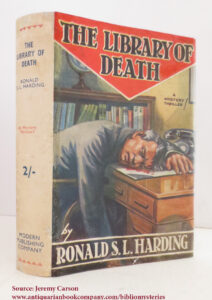 One of the lovely thing about murder mysteries is that sub-genres abound that cater to every taste. Bibliomysteries are a category of crime novel concerned with the world of authors, manuscripts, rare and deadly books, bookshops, libraries, etc., and always involve some sort of bookish skull-duggery. One of the pleasures of republishing Bruce Graeme is his detective novels almost always involve something bookish, whether it is the protaganist as crime writer (The Undetective) or the detective being a bookish sort (Thedore Terhune in Seven Clues in Search of a Crime) who’s adventures might involve the writing of a book (House With Crooked Walls), the selling of a book collection (Work for the Hangman), anonymous stories as clues (Ten Trails to Tyburn), the British book trade featuring a desperate (but hysterical) book auction (A Case of Books), or a mystery concerned with ancient books on smuggling (And a Bottle of Rum).
One of the lovely thing about murder mysteries is that sub-genres abound that cater to every taste. Bibliomysteries are a category of crime novel concerned with the world of authors, manuscripts, rare and deadly books, bookshops, libraries, etc., and always involve some sort of bookish skull-duggery. One of the pleasures of republishing Bruce Graeme is his detective novels almost always involve something bookish, whether it is the protaganist as crime writer (The Undetective) or the detective being a bookish sort (Thedore Terhune in Seven Clues in Search of a Crime) who’s adventures might involve the writing of a book (House With Crooked Walls), the selling of a book collection (Work for the Hangman), anonymous stories as clues (Ten Trails to Tyburn), the British book trade featuring a desperate (but hysterical) book auction (A Case of Books), or a mystery concerned with ancient books on smuggling (And a Bottle of Rum).
The bibliomystery dates back to at least Victorian times; examples include Scrope: or the Lost Library (1874), The Crime of Sylvestre Bonnard (1890), The Hidden Million: A Sensational Story (1883), and the wonderfully titled A Strange Manuscript Found in a Copper Cylinder (1888). Mystery expert and editor Otto Penzler’s annotated bibliography of bibliomysteries published between 1849-2000 contains well over 1,000 entries. If your appetite for original bibliomysteries is whetted, antiquarian bookseller Jeremy Carson is a good place to start. Often the titles alone are fascinating – who could resist browsing “The Secret Book” or “Murder at the Bookstall” or the sublimely headed “Death of A Fashion Writer”? After all, if you love books not much can beat reading a mystery book about books and the people who hang around them.